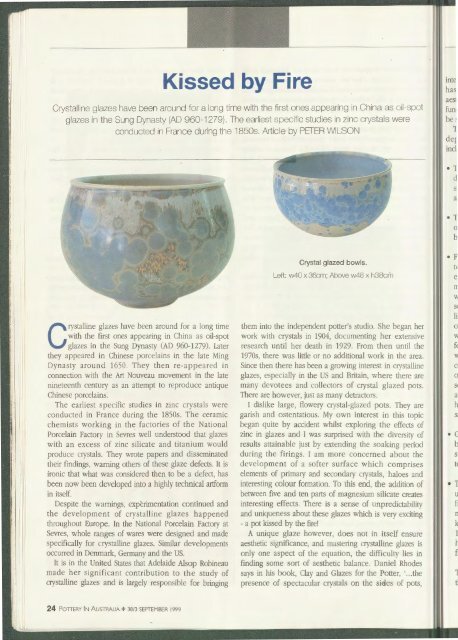Pottery In Australia Vol 38 No 3 September 1999
You also want an ePaper? Increase the reach of your titles
YUMPU automatically turns print PDFs into web optimized ePapers that Google loves.
• 1<br />
d<br />
s<br />
a<br />
Kissed by Fire<br />
Crystalline glazes have been around for a long time with the first ones appearing in China as oil-spot<br />
glazes in the Sung Dynasty (AD 960-1279). The earliest specific studies in zinc crystals were<br />
conducted in France during the 1850s. Article by PETER WILSON<br />
inte<br />
has<br />
aes1<br />
fun1<br />
be:<br />
1<br />
der<br />
incl<br />
Crystalline glazes have been around for a long time<br />
with the first ones appearing in China as oil-spot<br />
glazes in the Sung Dynasty (AD 960-1279). Later<br />
they appeared in Chinese porcelains in the late Ming<br />
Dynasty around 1650. They then re-appeared in<br />
connection with the Art <strong>No</strong>uveau movement in the late<br />
nineteenth century as an attempt to reproduce antique<br />
Chinese porcelains.<br />
The earliest specific studies in zinc crystals were<br />
conducted in France during the 1850s. The ceramic<br />
chemists working in the factories of the National<br />
Porcelain Factory in Sevres well understood that glazes<br />
with an excess of zinc silicate and titanium would<br />
produce crystals. They wrote papers and disseminated<br />
their findings, warning others of these glaze defects. It is<br />
ironic that what was considered then to be a defect, has<br />
been now been developed into a highly technical artf orm<br />
in itself.<br />
Despite the warnings, experimentation continued and<br />
the development of crystalline glazes happened<br />
throughout Europe. <strong>In</strong> the National Porcelain Facto1y at<br />
Sevres, whole ranges of wares were designed and made<br />
specifically for crystalline glazes. Similar developments<br />
occurred in Denmark, Germany and the US.<br />
It is in the United States that Adelaide Alsop Robineau<br />
made her significant contribution to the study of<br />
crystalline glazes and is largely responsible for bringing<br />
Crystal glazed bowls.<br />
Left: w40 x 36cm; Above w48 x h<strong>38</strong>cm<br />
them into the independent potter's studio. She began her<br />
work with crystals in 1904, documenting her extensive<br />
research until her death in 1929. From then until the<br />
1970s, there was little or no additional work in the area.<br />
Since then there has been a growing interest in crystalline<br />
glazes, especially in the US and Britain, where there are<br />
many devotees and collectors of crystal glazed pots.<br />
There are however, just as many detractors.<br />
I dislike large, flowery crystal-glazed pots. They are<br />
garish and ostentatious. My own interest in this topic<br />
began quite by accident whilst exploring the effects of<br />
zinc in glazes and I was surprised with the diversity of<br />
results attainable just by extending the soaking period<br />
during the firings. I am more concerned about the<br />
development of a softer surface which comprises<br />
elements of prima1y and secondary crystals, haloes and<br />
interesting colour formation. To this end, the addition of<br />
between five and ten parts of magnesium silicate creates<br />
interesting effects. There is a sense of unpredictability<br />
and uniqueness about these glazes which is very exciting<br />
- a pot kissed by the fire!<br />
A unique glaze however, does not in itself ensure<br />
aesthetic significance, and mastering crystalline glazes is<br />
only one aspect of the equation, the difficulty lies in<br />
finding some sort of aesthetic balance. Daniel Rhodes<br />
says in his book, Clay and Glazes for the Potter, ' ... the<br />
presence of spectacular crystals on the sides of pots,<br />
• T<br />
0<br />
b<br />
• F<br />
tc<br />
e<br />
II<br />
V.<br />
SI<br />
Ii<br />
0<br />
V.<br />
fc<br />
V.<br />
Cl<br />
0<br />
S<<br />
a1<br />
h<br />
S,<br />
• G<br />
b<br />
Sl<br />
tc<br />
• T<br />
u<br />
fr<br />
rr<br />
k<br />
11<br />
h<br />
fi<br />
T<br />
tr<br />
24 POTTERY IN AUSTRALIA+ <strong>38</strong>/3 SEPTEMBER <strong>1999</strong>

















